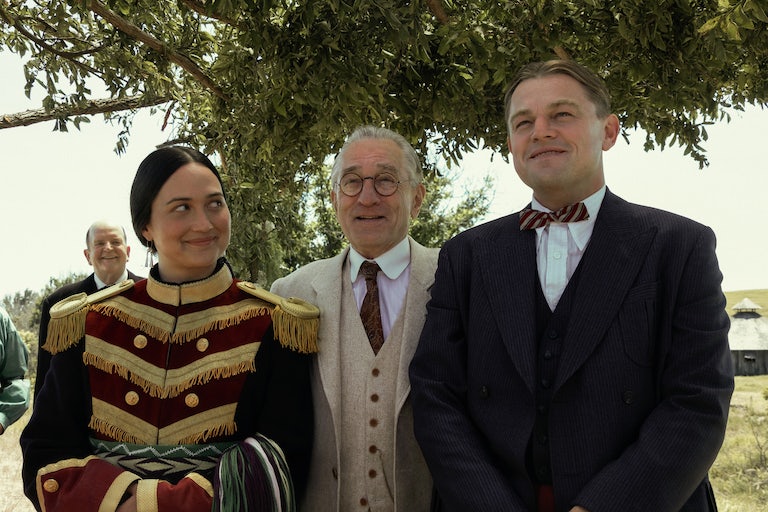Killers of the Flower Moon Review: Scorsese scores another success
One of the most highly anticipated movies this month has finally been released. Martin Scorsese is back with his new Western epic drama Killers of the Flower Moon. With outstanding performances and cinematography, this film is not one to be missed. Please be warned that there will be spoilers ahead.
In Scorsese’s new film, the FBI starts an investigation on the murders of dozens of Osage tribe members after oil has been discovered on their land in the early 1920s. Focusing in on newly-returned World War I veteran Ernest Burkhart (Leonardo Dicaprio), the film documents, with a liberal hand of fiction, his trek out to Oklahoma to become rich with the help of his uncle William King Hale (Robert De Niro). Burkhart meets and marries an Osage woman named Mollie (Lily Gladstone), who struggles with diabetes and familial loss throughout the film.
The concept of a “standout performance” cannot be applied to Killers of the Flower Moon, for every performance adds immense value to the project. Leonardo DiCaprio drives the narrative as the movie’s unfavorable protagonist, Ernest Burkhart. We meet Ernest for the first time being driven to his uncle’s large, beautifully imposing home while Ernest looks covered in grease, dirt, mud, and any other filthy substance imaginable for 1920s Oklahoma. This dichotomy of a large world with imposing situations to Ernest’s simple existence concisely defines Ernest’s journey during every part of the story. When his uncle (De Niro) wants Mollie to be poisoned, he gives Ernest a vial of poison to add to her insulin. His uncle doesn’t tell him what is in the vial and just states that it needs to be done in order to save her life. Ernest, loving Mollie so deeply but also being an incredibly stupid man, goes ahead with the vial addition without question. In terms of loving Mollie, Ernest is portrayed as intensely in love with her but also bigoted against Native people and their traditions. Throughout the movie, there is forever a feelings of covert tension between both white and Osage people, even in moments of joy. DiCaprio’s talent allows for the complexities of Mr. Burkhart to take hold of the screen and connect with the audience.
Mollie Burkhart, played by Lily Gladstone, demonstrates the everlasting pain and toll the Native deaths have in the story. She is plagued with diabetes, not being unable to control her funds as a marked ‘incompetent,’ and her love of a contradictory and destructive man. Gladstone’s performances highlights the value of family and tradition in Mollie’s life while allowing her to be an independent entity. In a private room at the courthouse, Mollie presses Ernest on what was in the insulin shots he gave her. Though up for interpretation whether Ernest knew or not, Gladstone holds both Mollie’s love for Ernest and deep sense of betrayal simultaneously. Just like with other characters, her complexity intrigues her to the audience.
Robert De Niro captivates the screen as William King Hale, a kingpin of oil and ringleader of the Osage murders. The intense manipulation, greed, and power of De Niro’s character strikes the viewer at exactly the right time. Hale cozies up to the Osage, donating large amounts of money for schools and hospitals, in order to gain their trust before the murders. Oddly, he makes Ernest, his nephew, call him King, signifying his exceptionally weird power complex. Even when in custody, with his own family testifying against him, he still attempts to manipulate Ernest into not testifying. The short story is that one will not find a more sleazy, morally corrupt Oklahoma business man than De Niro in Killers of the Flower Moon.
Despite my rambling over the exquisite performances, the technical aspects do aid the film exponentially in delivering its message. The use of black-and-white film, in combination with the Americana-harkening score, creates a perfect tone for the movie. Both aspects are reminiscent of the time in which the movie is set, thereby tying the audience visually and audibly to the setting and characters. Many shots of intimate conversations between characters take place in a movie theater, furthering my point while signifying the power of cinema as a place for idea spreading, interpretation, and discussion (covert or otherwise). As a side note, the costumes were incredibly well done, seemingly used natural fibers that would be used in the time, and represent the cultures depicted in the film.
Throughout the movie, what was most apparent about the film was its stark messaging. At different points, the racism of the times rears its ugly head, with examples being the K.K.K. nonchalantly participating in a parade, the Tulsa race riots, and Ernest being called a Jew due to his greed. These moments seem much more important in retrospect when the viewer sees the last scene of the film: a live radio show. The story of the Killers of the Flower Moon is being told to this all-white audience with fanfare and cheer. When Mr. Scorsese walks up to the mic to deliver the ending, he reads to the audience Mollie Burkhart’s obituary, including the fact that no one was charged in her death and there wasn’t an investigation. This reminder of the gravity of the situation quickly becomes apparent to the audience on the screen, as well as the audience in the theater. It’s an uncomfortable reminder of how Native tragedies have been used to entertain white audiences instead of focusing on the humanity of those who lives were lost. The film blankly stares into the real-life theater as the audience asks themselves, “Am I engaging in the same behavior watching this very film?”
Scorsese truly makes audiences think with Killers of the Flower Moon. From performances to technical achievements, as well as thought-provoking messaging, this is one movie the masses should not miss. Killers of the Flower Moon is now playing in theaters.










